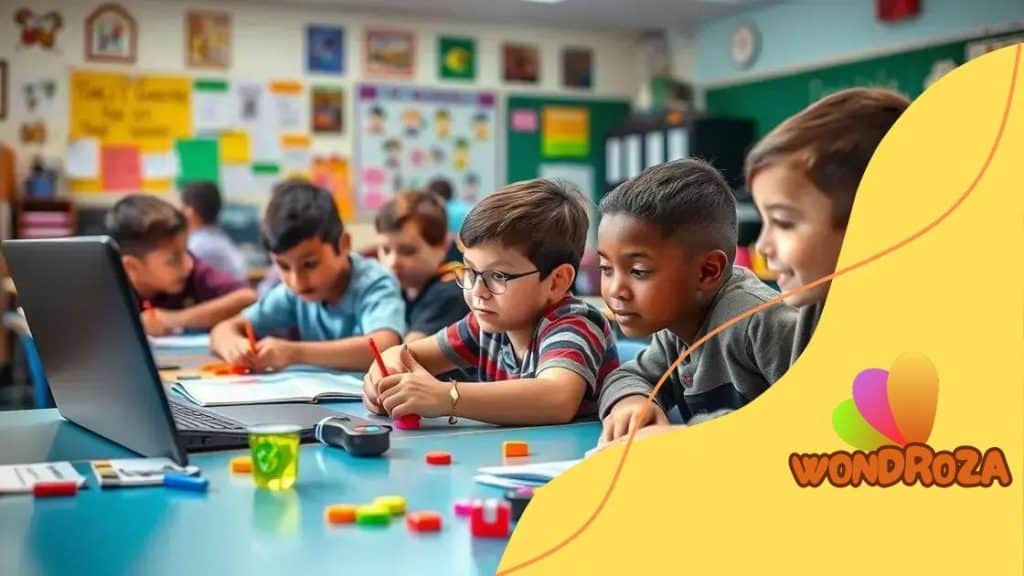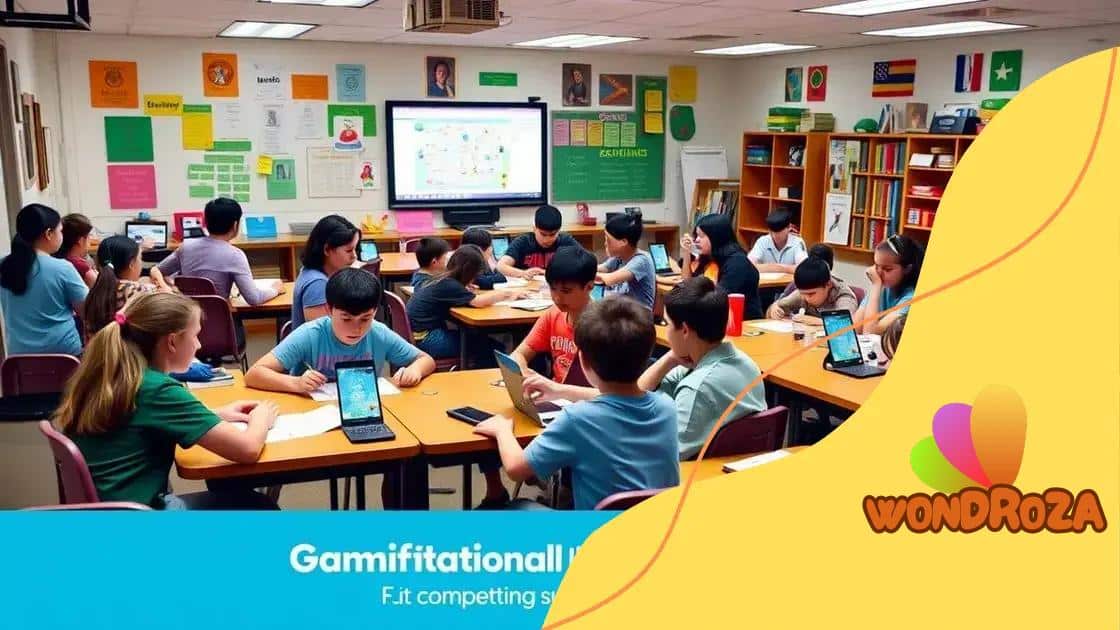How gamification is being used to improve student engagement

Gamification enhances student engagement by incorporating game elements like points, badges, and challenges, motivating students to actively participate and improving learning outcomes.
How gamification is being used to improve student engagement is changing the educational landscape. Have you ever wondered how game mechanics can make learning more appealing? Let’s dive into this exciting trend.
Understanding gamification and its principles
Understanding gamification and its principles can greatly enhance the learning experience for students. At its core, gamification involves incorporating game elements into non-game contexts, such as education, to foster engagement and motivation.
This approach taps into students’ natural desires for achievement and competition. By setting clear goals, students can feel rewarded as they progress through learning activities.
Key Principles of Gamification
There are several essential principles that drive the effectiveness of gamification:
- Rewards: Students receive points or badges as they complete tasks, which incentivizes participation.
- Progress Tracking: Visual indicators of progress help students see how far they’ve come.
- Challenges: Presenting problems that require critical thinking can make learning more stimulating.
- Feedback: Instant feedback helps students understand their mistakes and encourages improvement.
By integrating these principles, educators can create a gamified learning environment that encourages students to take an active role in their education. In a gamified classroom, lessons might include competitive elements, such as team challenges or leaderboard rankings, which can enhance cooperation among peers.
Furthermore, gamification promotes a culture of achievement and collaboration. Students often feel more motivated when learning is framed as a game. This makes learning not only fun but also rewarding.
Benefits of gamification in education
The benefits of gamification in education are extensive and can positively impact both students and teachers. By transforming learning into a more enjoyable experience, students become more engaged and motivated.
One of the primary advantages of gamification is that it enhances student participation. When students face challenges that involve game-like elements, they are more likely to actively participate rather than remain passive learners.
Increased Motivation
Gamification fuels motivation through various elements:
- Immediate Rewards: Students receive instant feedback and rewards that boost their enthusiasm.
- Goal Setting: Setting achievable goals gives students a sense of purpose and direction.
- Healthy Competition: Friendly competition among peers encourages students to excel.
- Personalization: Gamified experiences can often be tailored to fit individual students’ needs and learning styles.
Another benefit is the development of critical thinking skills. Gamified lessons often require students to solve problems or think strategically, preparing them for real-world scenarios. This not only makes learning relevant but also fosters essential skills such as collaboration and communication.
Furthermore, gamification creates a supportive learning environment. Students feel safe to take risks when they know that making mistakes is part of the game. They learn resilience and adaptability, which are important traits for lifelong learning.
All these benefits contribute to a more dynamic classroom atmosphere. Teachers can leverage gamification to create interactive lessons that cater to various learning preferences, making education a more inclusive experience.
Real-life examples of successful gamification

Real-life examples of successful gamification bring the concept to life and showcase its effectiveness in various educational settings. Many educators around the world have implemented gamification techniques, resulting in notable improvements in student engagement and learning outcomes.
One significant case is the use of gamified experiences in language learning. Platforms like Duolingo incorporate game mechanics to motivate users. By rewarding users with points and badges for completing lessons, learners remain engaged and enthusiastic about progressing.
Case Studies in Gamification
Another inspiring example is classroom initiatives. Educators have created their own gamified systems to enhance participation. One teacher developed a competition where students earn points for participating in discussions or completing assignments. These points lead to rewards, such as extra recess or homework passes.
- Behavioral Challenges: Some teachers design a point system to help manage classroom behavior. Students earn points for good behavior, which they can exchange for privileges.
- Interactive Quests: In science classes, educators have implemented quests where students complete experiments and document their findings for points, mimicking a role-playing game.
- Collaborative Projects: Gamification can also enhance group projects. Teams can compete for points based on creativity and collaboration while presenting their projects.
These examples illustrate the diverse ways gamification can be tailored to different subjects and settings. Not only does it enhance motivation, but it also fosters a sense of community among students. By working together to achieve game-like goals, students form stronger relationships and improve their social skills.
Furthermore, educators often report higher levels of student enthusiasm and lower dropout rates when gamification is involved. As a result, gamification is gaining traction as a powerful educational tool.
Strategies for implementing gamification
Implementing gamification in education requires thoughtful strategies. Educators need to design experiences that genuinely engage students while enhancing their learning outcomes. Here are some effective strategies to consider.
Define Clear Objectives
Before starting, identify the specific goals you want to achieve with gamification. This might include improving student participation, enhancing knowledge retention, or fostering teamwork. Clear objectives guide the design process and set expectations for students.
Incorporate Game Elements
To gamify your lessons, include various game elements. Here are some popular components:
- Points System: Assign points for completing tasks, participating in discussions, or helping peers.
- Levels: Create levels that students can achieve as they progress, encouraging them to advance.
- Badges: Offer badges for specific accomplishments, such as mastering a skill or completing a project.
- Leaderboards: Display progress in the classroom to encourage friendly competition.
Utilizing these elements can transform mundane lessons into exciting challenges that capture students’ attention.
Encourage Collaboration
Incorporating teamwork fosters a sense of community. Group activities that require collaboration help students enhance their social skills. Assign tasks that challenge groups to use creativity and critical thinking, allowing them to support each other toward common goals.
In addition, providing opportunities for peer feedback can create an environment where students learn from one another. This shared learning experience increases engagement and makes education more enjoyable.
Use technology to facilitate gamification, such as learning management systems that support game-like features. Many platforms allow teachers to integrate quizzes, interactive tools, and gamified assessments seamlessly into their curriculum. By leveraging technology, you can streamline the implementation process and create a dynamic learning experience.
Measuring the impact of gamification on engagement
Measuring the impact of gamification on engagement is crucial for educators. Understanding how gamified elements influence student motivation can help improve teaching strategies and learning experiences. To gauge effectiveness, several methods can be applied.
One way to measure impact is through surveys and feedback. Gathering student input can reveal their perceptions of gamified lessons. This feedback is valuable for assessing what aspects resonate most with students and which need adjustments.
Key Metrics to Track
Different metrics can help quantify the impact of gamification on engagement:
- Participation Rates: Track how often students participate in gamified activities compared to traditional methods.
- Assessment Scores: Analyze test and assignment scores before and after implementing gamification.
- Attendance: Monitor attendance rates to see if there’s an increase when gamification is introduced.
- Time on Task: Measure the amount of time students spend on tasks when gamification is involved versus those without.
Another effective way to assess impact is through observational studies. Teachers can observe classroom dynamics to see how students interact during gamified lessons. Look for signs of enthusiasm, collaboration, and competition, which are indicators of high engagement.
Finally, data analytics can provide insights into student behavior. Many educational platforms collect data on student interactions and progress, allowing teachers to analyze trends over time. This data can show whether gamification leads to improved academic performance and greater interest in subjects.
By collecting and analyzing these metrics, educators can make informed decisions about the effectiveness of gamification in their classrooms. This ongoing assessment ensures that teaching strategies remain relevant and effective for engaging students.
FAQ – Frequently Asked Questions about Gamification in Education
What is gamification in education?
Gamification in education involves using game design elements to enhance learning experiences, increasing student engagement and motivation.
How can gamification improve student participation?
By incorporating game mechanics like points, badges, and challenges, students are more likely to participate actively in lessons.
What are some examples of gamification strategies?
Examples include using point systems, collaborative group activities, and setting clear objectives to motivate students.
How can educators measure the impact of gamification?
Educators can measure impact by tracking participation rates, assessing scores, gathering student feedback, and analyzing data trends.





